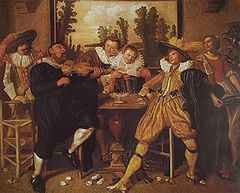Bloomers

The bloomers are wide, loosely falling trousers made of wool that reach to the knee and are closed with ribbons. At the beginning of the 17th century they followed the short, stuffed trousers of the Spanish fashion that had dominated until then .
In addition, similarly cut, but ankle-length trousers that are closed or tied at ankle height with a cuff , elastic band or straps are now called bloomers. Jogging pants often have a bloomers cut with a moderate width.
The army drum was part of the Spanish court costume , but outside the court people wore stuffed bloomers, which gradually replaced the much maligned harem pants in Germany and finally gave up their thick padding. The stockings worn with bloomers were held below the knee by garters decorated with loose bows.
Baggy pants have remained part of folk costumes up to the present day and also live on in clothing fashion. For example, at the end of the 19th century, wide trousers with knees appeared for the cycling ladies.
See also
- Harem pants
- Şal û şapik
- Sirwal (also: Şalvar, Sarouel, "harem pants")
- Dalwar
literature
- Erika Thiel: History of the Costume . Henschel-Verlag, Berlin, 8th edition 2004, ISBN 3-89487-260-8 , p. 212.
